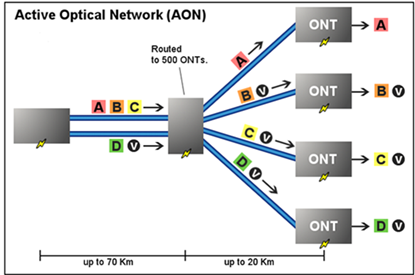Nowadays, the requirements for higher Internet access speed keep growing in different applications such as video conference, 3D and cable TV, which result in popularity of FTTH (fiber-to-the-home) deployments. Passive Optical Networks (PON), as the leading technology used in FTTH applications, are also widely used. PON transceivers are one of the important components in PON systems. This post intends to describe some basic knowledge of PON transceivers.
PON transceiver is a type of optical transceivers which often uses different wavelengths to transmit and receive signals between an OLT (Optical Line Terminal) and ONTs (Optical Network Terminals, also called ONU). According to different standards, PON transceivers can be divided into different types. There are diplexer and the triplexer transceivers on the basis of wavelengths. For the diplexer transceivers, the 1310nm wavelength is for the upstream and 1490nm for the downstream wavelength. While for the triplexer transceiver, the 1550nm wavelength is used in the downstream direction. Of course, it is also possible that 1490nm wavelength is allocated in the downstream direction by using video over IP technologies.

According to the plugged-in device, there are OLT and ONU transceivers. Generally, OLT transceiver is more complicated than ONU transceiver. Because one OLT transceiver may need to communicate with up to 64 ONU transceivers.
It’s know to all that there are two usual network architectures in PON systems: GPON (Gigabit Passive Optical Network) and EPON (Ethernet Passive Optical Network). Both of them offer users high-speed services over an all-optical access network. As we have mentioned above, PON transceiver can be classified into OLT and ONU transceivers. Here mainly introduce two common OLT transceivers used in GPON or EPON network.
The GPON OLT transceiver is designed for GPON transmission. In order to illustrate this transceiver clear, let’s take the GPON OLT SFP module for an example (shown as following picture). The transceiver uses 1490nm continuous-mode transmitter and 1310nm burst-mode receiver. The transmitter section uses a high efficiency 1490nm DFB laser and an integrated laser driver which is designed to be eye safety under any single fault. The receiver section uses an integrated APD detector and bursts mode pre-amplifier mounted together. To provide fast settling time with immunity to long streams of Consecutive Identical Digits (CID), the receiver requires a reset signal provided by the media access controller (MAC). The GPON OLT SFP transceiver is a high performance and cost-effective module for serial optical data communication applications to 2.5Gpbs.

EPON OLT transceiver is designed for PON applications. It has SFP, XFP and SFP+ packages. Here we also introduce this transceiver by taking EPON OLT SFP transceiver as an example. Generally, EPON OLT SFP transceivers support 1.25Gbps downstream and 1.25Gbps upstream in EPON applications. Like the GPON OLT SFP transceiver, they also have 1490nm continuous-mode transmitter and 1310nm burst-mode receiver. And their transmission reach is 20 km. The transmitter section uses a 1490nm DFB with automatic power control (APC) function and temperature compensation circuitry, which can ensure stable extinction ratio overall temperature range. And the receiver section has a hermetically pre-amplifier and a limiting amplifier with LVPECL compatible differential outputs.

Although PON transceivers provide a satisfying performance in FTTH applications, there still exists some challenges in the following aspects:
- Burst-mode optical transmission technologies for the upstream link.
- High-output-optical-power and high-sensitivity OLT at the CO (central office) are needed for the losses introduced by the optical splitters and fibers connecting subscribers’ premises.
- The Optical Line Terminal (OLT) RX needs to be able to receive packets with large differences in optical power and phase alignment.
- Quick rise/fall time to minimize guard time during transmission.
PON transceiver is a high performance module for single fiber communications by using continuous-mode transmitter and burst-mode receiver with different data rate and wavelengths. In this post, the basis and common types of PON transceivers are illustrated. Hope it could help you. For more information, please visit FS.COM.



